India faces growing challenges from severe monsoon flooding and extreme weather, exacerbated by climate change, highlighting the urgent need for enhanced forecasting and early warning systems.
Climate Hazards in India
- Monsoon Impact: Recent monsoons have caused recurrent flooding across many states, including Assam, Bihar, Odisha, and eastern Uttar Pradesh.
- Alternating Hazards: A study by the Council on Energy, Environment, and Water (CEEW) highlights that approximately 40% of India’s districts face alternating climatic challenges.
- Rainfall Trends: An analysis of 40 years of rainfall data by CEEW shows that there has been an increase of up to 64% in heavy rainfall days during the monsoons over the last decade.
- Flood Exposure: Two-thirds of India’s population is exposed to flood risks.
Enroll now for UPSC Online Classes
Current Gaps in Weather Forecasting
- Despite two-thirds of India’s population being exposed to flood risks, only a third of the flood-prone population is covered by early warning systems.
- This stands in stark contrast to cyclone-prone areas, which are fully covered by cyclone early warning systems.
Mission Mausam
- Mission Overview: Launched in 2024, ‘Mission Mausam’ aims to enhance India’s weather observation, improve forecasting models, and explore weather modification techniques.
- Implementation: Implemented by the India Meteorological Department (IMD), the National Centre for Medium Range Weather Forecasting (NCMRWF), and the Indian Institute of Tropical Meteorology (IITM), with a budget of ₹2,000 crore.
- Focus: The initiative focuses on expanding weather observation networks, integrating machine-learning and data-driven approaches, and developing models for atmospheric analysis and weather modification.
Priorities for Mission Mausam
- Expanding Weather Observation Networks
- India currently has 39 Doppler Weather Radars (DWRs), but critical areas such as the western coast and major cities like Ahmedabad, Bengaluru, and Jodhpur remain uncovered.
- The increasing frequency of cyclones in the Arabian Sea highlights the need for more radars along the west coast.
- Expanding radar coverage in urban centres prone to frequent flooding is crucial for better preparedness.
- Open Access to Weather Data
- Countries like the U.S., U.K., and France provide open access to weather data, allowing for the development of new technologies and localised tools.
- IMD offers limited data through its portal, with restrictions on access for academic and research purposes.
- Recommendations:
- Establish infrastructure for the open distribution of weather data.
- ‘Mission Mausam’ should make data from radars, wind profilers, and radiometers publicly available to encourage innovation in early warning systems.
- Enhancing Communication Tools
- IMD shares weather information via web and mobile apps, providing district-wise warnings from hourly to four-day forecasts.
- Recommendations:
- Enhancing User Experience: Tools need improvement to help users better understand and act on warnings, especially for reaching the last mile.
- Capacity Building: ‘Mission Mausam’ should focus on educating users with videos, media guides, and more intuitive applications to enhance preparedness.
- Better Policy and Infrastructure: For regions like Assam, which face annual floods, improved policies and infrastructure are essential to ensure better preparedness.
Check Out UPSC NCERT Textbooks From PW Store
Conclusion
Mission Mausam is a crucial initiative for enhancing India’s climate resilience and preparedness for extreme weather events, enabling the country to better mitigate the impacts of climate change.
![]() 19 Oct 2024
19 Oct 2024

